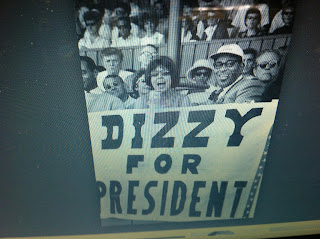BLACK SOCIAL HISTORY Born on October 21, 1917, in Cheraw, South Carolina, Dizzy Gillespie, known for his "swollen" cheeks and signature (uniquely angled) trumpet's bell, got his start in the mid-1930s by working in prominent swing bands, including those of Benny Carter and Charlie Barnet. He later created his own band and developed his own signature style, known as "bebop," and worked with musical greats like Cab Calloway,
Ella Fitzgerald, Earl Hines, Charlie Parker and Duke Ellington. Gillespie's best-known compositions include "Oop Bob Sh' Bam," "Groovin' High," "Salt Peanuts," "A Night in Tunisia" and "Johnny Come Lately." Gillespie died in New Jersey in 1993. Today, he is considered one of the most influential figures of jazz and bebop.QUOTES
"The music of Charlie Parker and me laid a foundation for all the music that is being played now. Our music is going to be the classical music of the future."
– Dizzy Gillespie
Early Life
Famed jazz trumpeter and composer Dizzie Gillespie was born John Birks Gillespie on October 21, 1917, in Cheraw, South Carolina. He would go on to become one of the most recognizable faces of jazz music, with his "swollen" cheeks and signature (uniquely angled) trumpet's bell, as well as one of the most influential figures of jazz and bebop.
When he was 18 years old, Gillespie moved with his family to Philadelphia, Pennsylvania. He joined the Frankie Fairfax Orchestra not long after, and then relocated to New York City, where he performed with Teddy Hill and Edgar Hayes in the late 1930s. Gillespie went on to join Cab Calloway's band in 1939, with whom he recorded "Pickin' the Cabbage"—one of Gillespie's first compositions, and regarded by some in the jazz world as his first attempt to bring a Latin influence into his work.
Commercial Success
From 1937 to '44, Gillespie performed with prominent swing bands, including those of Benny Carter and Charlie Barnet. He also began working with musical greats such as Ella Fitzgerald, Earl Hines,Jimmy Dorsey and Charlie Parker around this time. Working as a bandleader, often with Parker on saxophone, Gillespie developed the musical genre known as "bebop"—a reaction to swing, distinct for dissonant harmonies and polyrhythms. "The music of Charlie Parker and me laid a foundation for all the music that is being played now," Gillespie said years later. "Our music is going to be the classical music of the future."
In addition to creating bebop, Gillespie is considered one of the first musicians to infuse Afro-Cuban, Caribbean and Brazilian rhythms with jazz. His work in the Latin-jazz genre includes "Manteca," "A Night in Tunisia" and "Guachi Guaro," among other recordings.
Gillespie's own big band, which performed from 1946 to '50, was his masterpiece, affording him scope as both soloist and showman. He became immediately recognizable from the unusual shape of his trumpet, with the bell tilted upward at a 45-degree angle—the result of someone accidentally sitting on it in 1953, but to good effect, for when he played it afterward, he discovered that its new shape improved the instrument's sound quality, and he had it incorporated into all his trumpets thereafter. Gillespie's best-known works from this period include the songs "Oop Bob Sh' Bam," "Groovin' High," "Leap Frog," "Salt Peanuts" and "My Melancholy Baby.
Final Yearsson of the legendary musician. Gillespie composed most of the album's recordings, including "Serenade to Sweden," "Sophisticated Lady" and "Johnny Come Lately."
In the late 1950s, Gillespie performed with Duke Ellington, Paul Gonsalves and Johnny Hodges on Ellington's Jazz Party (1959). The following year, Gillespie released A Portrait of Duke Ellington (1960), an album dedicated to Ellington also featuring the work of Juan Tizol, Billy Strayhorn and Mercer Ellington,
Final Yearsson of the legendary musician. Gillespie composed most of the album's recordings, including "Serenade to Sweden," "Sophisticated Lady" and "Johnny Come Lately."
Gillespie's memoirs, entitled To BE or Not to BOP: Memoirs of Dizzy Gillespie (with Al Fraser), were published in 1979. More than a decade later, in 1990, he received the Kennedy Center Honors Award.































































































































No comments:
Post a Comment